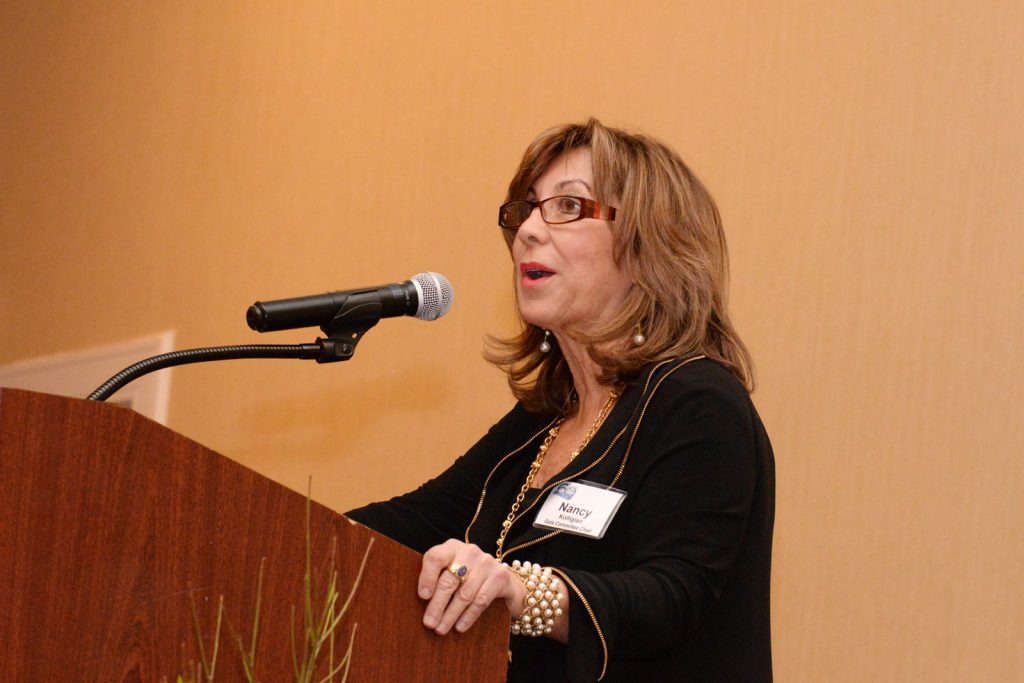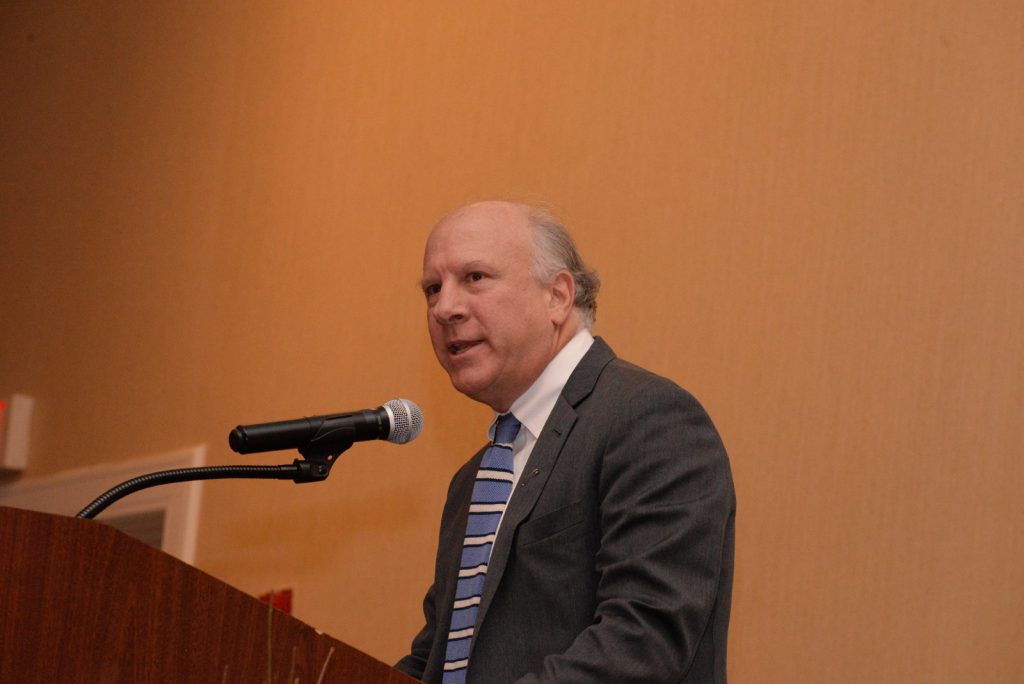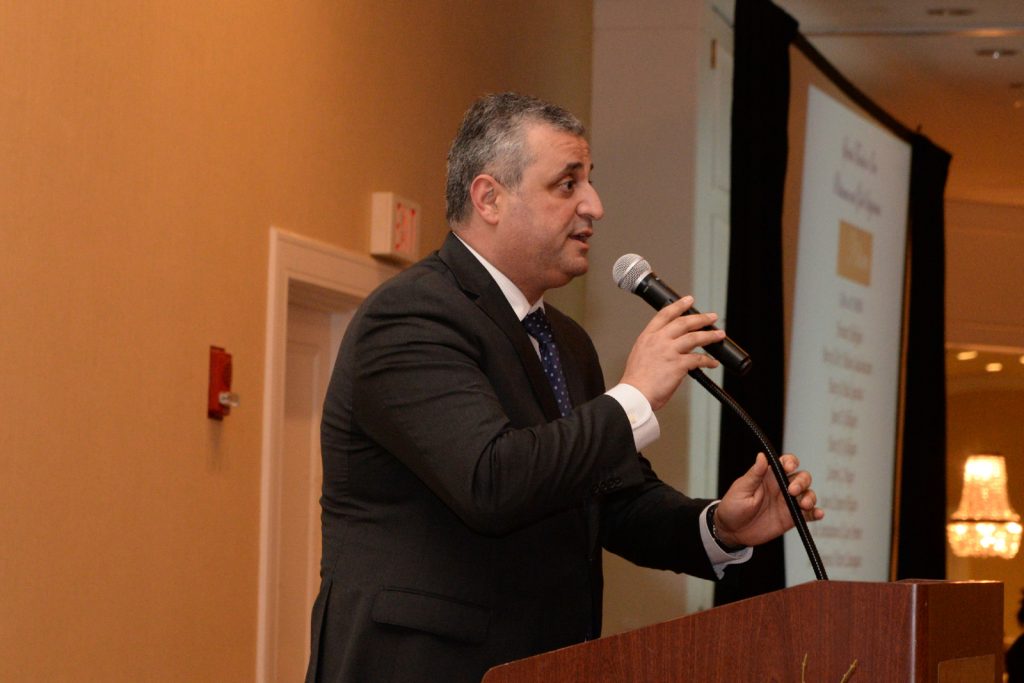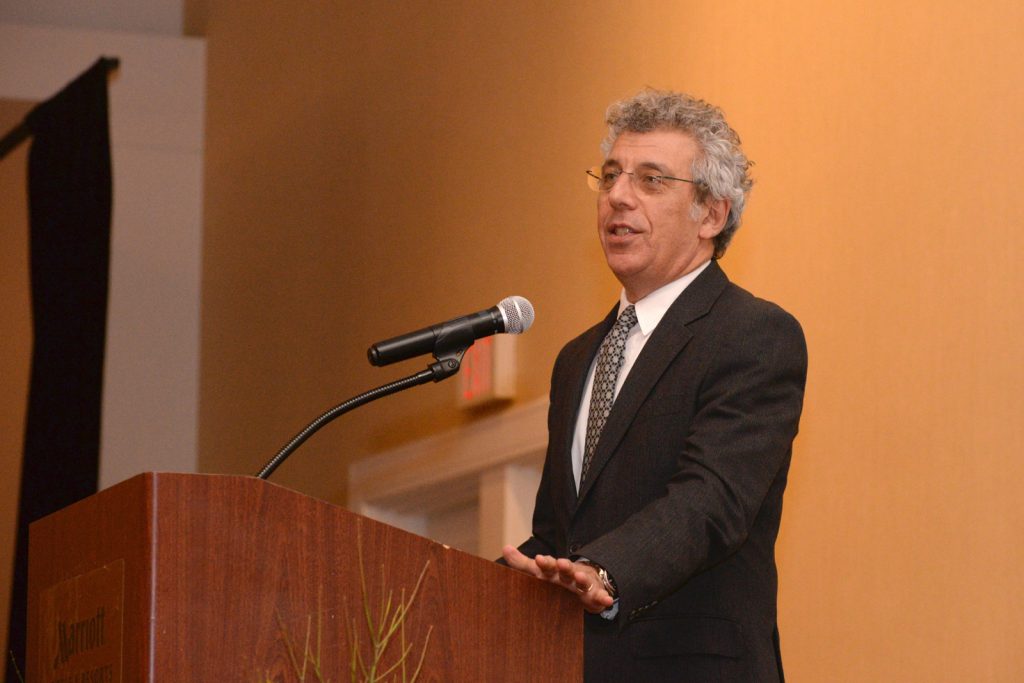Special for the Armenian Weekly
BURLINGTON, Mass. (A.W.)—Hundreds of supporters and guests gathered at the Boston Marriott Burlington to celebrate the 60th anniversary of the National Association for Armenian Studies and Research (NAASR).
The evening began with NAASR 60th Anniversary Gala Committee Chair Nancy Kolligian, who welcomed all the attendees and recognized the members of the Gala committee, who put in hard work to make the celebration a reality.
Kolligian spoke briefly about history of the organization and the vision of the 60 founding members: to form an educational organization dedicated to advance the study of Armenian history, culture, and literature, and to make it a relevant field of studies among American institutions.
Following Kolligian’s remarks, NAASR’s first Executive Director Sarah Ignatius spoke about the collective group of people at NAASR who are so dedicated to the prosperity of the organization. She emphasized that her work as the Executive Director is only just the beginning to many more successful years to come.
She then introduced the Editor-in-Chief of the Harvard Business Review and the evening’s Master of Ceremonies Adi Ignatius, to honor the evening’s special guests.
(Adi) Ignatius first read a letter from the Armenian Educational Foundation (AEF) that congratulated NAASR on their 60th anniversary. Ignatius stated that the letter showed the value of the work of the night’s honorees and all the scholars in the field of Armenian studies.
Ignatius then invited Gary Grigorian to present a medal to NAASR on behalf on Hayk Demoyan, the Director of the Armenian Genocide Museum-Institute in Yerevan. Ambassador Extraordinary and Plenipotentiary of the Republic of Armenia to the United States, Grigor Hovhannissian, then provided congratulatory remarks on behalf of the government of Armenia. In his remarks, Hovhannissian said that the work of NAASR has become a treasure for the global Armenian community and its work within American institutions will continue to have its impact.
Longtime and dedicated member of NAASR and the Director of the organization’s academic affairs, Marc Mamigonian then took to stage to present the Founders’ Award for Outstanding Contributions to the Field of Armenian Studies. The distinguished awardees included Dr. Nina Garsoian, Avedissian, Professor Emerita of Armenian History and Civilization of Columbia University, and Dr. Richard Hovannisian, Professor Emeritus of Modern Armenian and Near Eastern History of UCLA. Both have immensely shaped the field of Armenian studies through teaching, lectures, mentoring, research, and various publications.
Dr. Garsoian expressed her gratitude and briefly discussed her experience in Armenian studies and working with organizations like NAASR in a recorded video message.
Dr. Hovannisian, who had just returned from a conference in Istanbul earlier in the day, said that there was no training in Armenian studies when we began his career and noted the importance of organizations such as NAASR. He then congratulated NAASR on their achievement and thanked them for ensuring that the coming generation has a group of scholars and academics to learn from, so that they can help advance the field of Armenian studies.

Marc Mamigonian presenting Dr. Hovannisian with the NAASR Founders’ Award for Outstanding Contributions to the Field of Armenian Studies (Photo: Robert Pushkar)
The keynote speaker—actor, novelist, and playwright Eric Bogosian—opened his remarks by reminiscing about his childhood; how he attended Armenian Sunday school, attended Armenian weddings, served as an altar boy in Armenian church, and so forth. Bogosian said that growing up, he questioned what makes someone Armenian. In his remarks, he addressed the geographic aspect, the knowledge of language, and the fact of having relatives from older generations considering themselves Armenian.
“The notion of pure blood is fiction,” said Bogosian. “In the end, the lineage of our heritage is not merely a matter of genes or geopolitical borders… Our heritage is a heritage of culture and identity based on honor and self respect and dignity. In other words, pride,” he added.
Bogosian stressed that despite the fact that the Armenian people have experienced genocide and have survived, it is not the only way define the Armenian people. “Being a victim is not a point of pride,” said Bogosian.
Bogosian then emphasized that Armenians have a long, complex, and ancient history and the only way to truly understand it will be through scholarship and the type of work NAASR conducts. He also stressed that the various diasporan communities across the world make significant contributions to their local communities, while maintaining a pride for their culture. He considered the diaspora and the modern Republic of Armenia as one global network of Armenians, which both work to benefit one another.
“We lose as a nation when we allow people to insist on restricted definitions about what it means to be an Armenian,” said Bogosian. “Truly understanding Armenian history and culture should be the primary answer to the question of ‘what is an Armenian?’” added Bogosian.
Bogosian explained that it has become NAASR’s role to make sure that coming generations have the opportunity to learn about Armenian studies. By providing the necessary resources, NAASR becomes a great supporting structure in the field of Armenian studies—whether through its bookstore or within educational institutions in the U.S, according to Bogosian.
Bogosian then provided the importance of NAASR as a resource, as he detailed the impact the organizations had on his book Operation Nemesis. According to Bogosian, NAASR was able to get him the right books and put him in contact with the necessary authors and academics for him to properly conduct the necessary research for the book. He said that that he could not have finished his book without the help of NAASR and thanked them for their support in helping its launch.
“Armenia’s ancient history encompassing the period of empire, its early Christian period, its glorious medieval history, and the centuries of the Ottomans, particularly the 19th century—These are all very important areas of study… To simply repeat the folktales about Armenia and Armenians, passed down from our loving grandparents, is not enough. Simply to focus on tragedy is not enough. In order to fully understand who we are as a people—who we, ourselves are—in order that all Armenians can express the deep love and pride of all that is Armenian, we need to work so that we understand all of it. And that has been the wonderful accomplishment of NAASR,” said Bogosian.
A short video was then presented titled “A Meeting of Minds: NAASR and the Future of Armenian Studies” that was created by Artur Petrosyan, Karine Abalyan, and Christopher Zakian. The video highlighted Dr. Taner Akcam’s experience of unexpectedly finding pages of the missing memoir of Naim Bey—an Ottoman bureaucrat whose memoir is a documentation of telegraphs between him and Talat Pasha. Dr. Akcam knew that NAASR would support the further development and research of his project and that is why he approached them.
The video continued to showcase other scholars who have worked with NAASR in the field of academia, and displayed the results of NAASR’s work, which included the establishment of 14 modern day chairs in Armenian studies across the U.S. To this day, NAASR has given out countless grants, in order to further advance various fields of research in Armenian studies.
[youtube https://www.youtube.com/watch?v=HrRbF4qxmP8]
The final speaker of the evening was the Chair of the NAASR Board of Directors, Yervan Chekijian, who discussed his history with the organization and how he was introduced to it over 50 years ago. He then highlighted a few of the achievements of NAASR, including the establishment of the several chairs of Armenian Studies starting from the one at Harvard University. He then discussed how there has been a great increase in scholars in the field and number of books relating to Armenian studies thanks to NAASR.
Chekijian also provided details about the plans to renovate the current NAASR headquarters and asked for everyone’s support in this endeavor. He ended his address encouraging all current students to get involved in NAASR. “Stay engaged, stay in contact, do not get lost, and as you graduate and you move on to your profession, stay in touch with your counterparts… Make a personal commitment. 57 years ago, I did that. And I ask you, in order for us to grow, to make that kind of commitment,” said Chekijian.
The event concluded with the presentation of an illuminated manuscript that provided an opportunity for donors to have their names inscribed with calligraphy and to permanently make their mark in the field of Armenian studies. The manuscript, which is titled “Illuminators of the Future of Armenian Studies,” was created by artists Laura Zarougian and Knar Hovakimyan. Anyone could have his or her name, or the name of a loved one, inscribed for a pledge of $1,000.
Source: Armenian Weekly
Link: Celebrating 60 Years of Service: NAASR Gala Attracts Hundreds of Supporters






